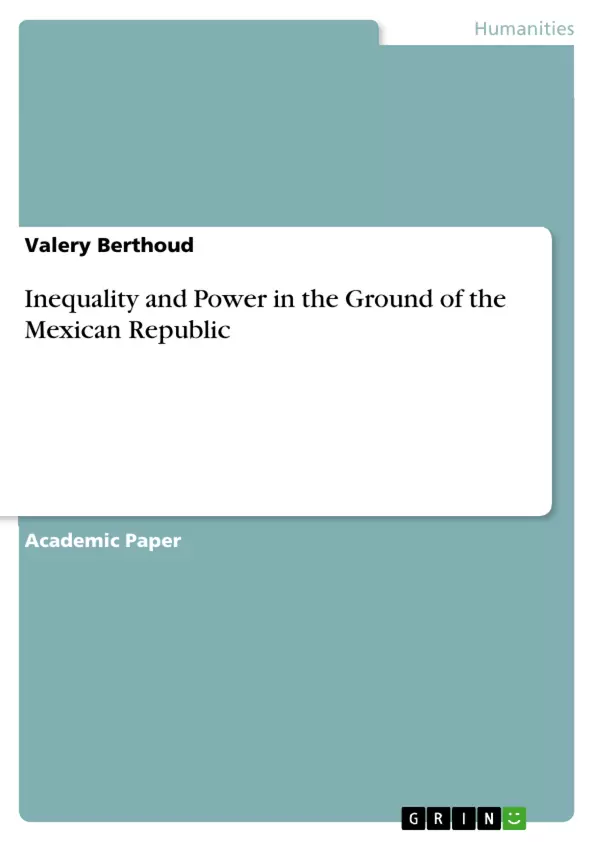Many Mexicans accept that life is not fair. A family guy, who lives from hand to mouth, does not care about changing the power structure. He rather thinks: “what do I win by fighting? what would give me the sacrifice? I earn money so that my daughter can go to school, and to buy one kilogram of tortillas.” He cannot take a chance. My original question was how Mexicans can tolerate an oligarchy. The answer is we do not want to have conflicts. We rather evade conflicts in exchange of accepting that life is not fair, that we live in a society with enormous moral and political problems such as discrimination and corruption. The brave Mexicans who try to rebel, get killed.
In this paper, I deal with recent research about inequality and power. By inequality, I understand that individuals do not have the same opportunities. People are treated badly for all kinds of unfair things: skin color, intellect, finance, ideals, gender, and everything else that makes who they are. To define power is very difficult. Power is a necessary means for the fulfillment of any goal. The more goals you set, the more power you need. Plato’s conception is different. In his dialogue, Gorgias, Socrates believes that the tyrants have little power. According to Socrates, someone possesses power if and only if he or she does the good because we do things for the sake of the good. Accordingly, if someone does not do the good, then he or she is powerless.
The aim of my work is to extend current knowledge of the power structure of Mexico. If we want to transform our society, we need to understand how it works. Inequality and power are the important issues that need to be studied in order to improve the standard of living of the population.
This paper is divided into three parts. The first part gives a brief overview of different approaches explicating inequality and power. Second part describes the case of Mexico. Third part analyzes the relation between the different approaches and the case of Mexico. The first part has eight sections that match with the eight sections of Part III. So Section 2.1 matches with Section 4.1, 2.2 with 4.2, 2.3 with 4.3, and so on, respectively.
Inhaltsverzeichnis (Table of Contents)
- 1 Introduction
- 2 Approaches Explicating Power And Inequality
- 2.1 The Social Psychology of Power
- 2.2 Emergence of Power Structures
- 2.2.1 Egalitarian Behavior
- 2.3 The Stability of Democracy
- 2.4 Transformation of the Western State
- 2.5 Globalization and Inequality
- 2.6 Inequality And Institutions
- 2.7 The Great Leveler
- 2.8 Welfare State
- 3 The Case of Mexico
- 3.1 Peculiarities of Mexican History
- 3.2 Violence in Mexico
- 3.3 Complexity of Mexico's Anthropology
- 3.4 Power Structure of Modern Mexico
- 3.5 Mexico as a Semi-periphery Country
- 4 Do the Previous Approaches Relate to the Case of Mexico?
- 4.1 Pursuit of Power
- 4.2 Egalitarian Indigenous Communities As the Lower Stratum
- 4.3 Democracy in Mexico
- 4.4 Incoherent Autocracy
- 4.5 Higher or Lower Inequality?
- 4.6 Mexican Institutions
- 4.7 Is There Any Hope?
- 4.8 What Can Be Done?
- 5 Summary
Zielsetzung und Themenschwerpunkte (Objectives and Key Themes)
This paper aims to contribute to the understanding of the power structure in Mexico, focusing on recent research about inequality and power. The work explores how power dynamics and inequality influence Mexican society and its development.
- The distribution of power and inequality within societies.
- The impact of power structures on individual behavior and societal structures.
- The role of social psychology, sociology, anthropology, economics, political science, and history in explaining power and inequality.
- The specific case of Mexico, including its historical context, political landscape, and social dynamics.
- The potential for change and the challenges of addressing inequality and power imbalances in Mexico.
Zusammenfassung der Kapitel (Chapter Summaries)
- Chapter 1: Introduction This chapter introduces the topic of inequality and power in Mexico, starting with personal observations about the acceptance of inequality by some Mexicans. The author outlines the challenges of defining inequality and power, referencing Plato's conception of power.
- Chapter 2: Approaches Explicating Power And Inequality This chapter explores various approaches to understanding inequality and power, including the Gini coefficient and its limitations. It delves into perspectives from social psychology, sociology, anthropology, economics, political science, and history.
- Chapter 2.1: The Social Psychology of Power This section examines the social psychology of power, highlighting the influence of powerful individuals and the relationship between power and corruption.
- Chapter 2.2: Emergence of Power Structures This section focuses on the emergence of power structures from a sociological perspective, analyzing the different levels of signaling asymmetries and the role of coercion and legitimization.
- Chapter 2.2.1: Egalitarian Behavior This section investigates the possibility of egalitarian behavior, exploring the characteristics of autonomous small-scale societies and the mechanisms they employ to maintain equality.
- Chapter 3: The Case of Mexico This chapter explores the unique historical, political, and social context of Mexico. It discusses the peculiarities of Mexican history, the prevalence of violence, the complexities of Mexican anthropology, and the current power structure.
- Chapter 4: Do the Previous Approaches Relate to the Case of Mexico? This chapter examines the applicability of the theoretical frameworks presented in previous chapters to the specific case of Mexico, exploring topics like the pursuit of power, the role of indigenous communities, the state of democracy, and the potential for change.
Schlüsselwörter (Keywords)
The central keywords of this work include inequality, power, Mexico, power structures, social psychology, sociology, anthropology, economics, political science, history, Gini coefficient, egalitarian behavior, corruption, and indigenous communities.
- Quote paper
- Valery Berthoud (Author), 2017, Inequality and Power in the Ground of the Mexican Republic, Munich, GRIN Verlag, https://www.grin.com/document/450140



